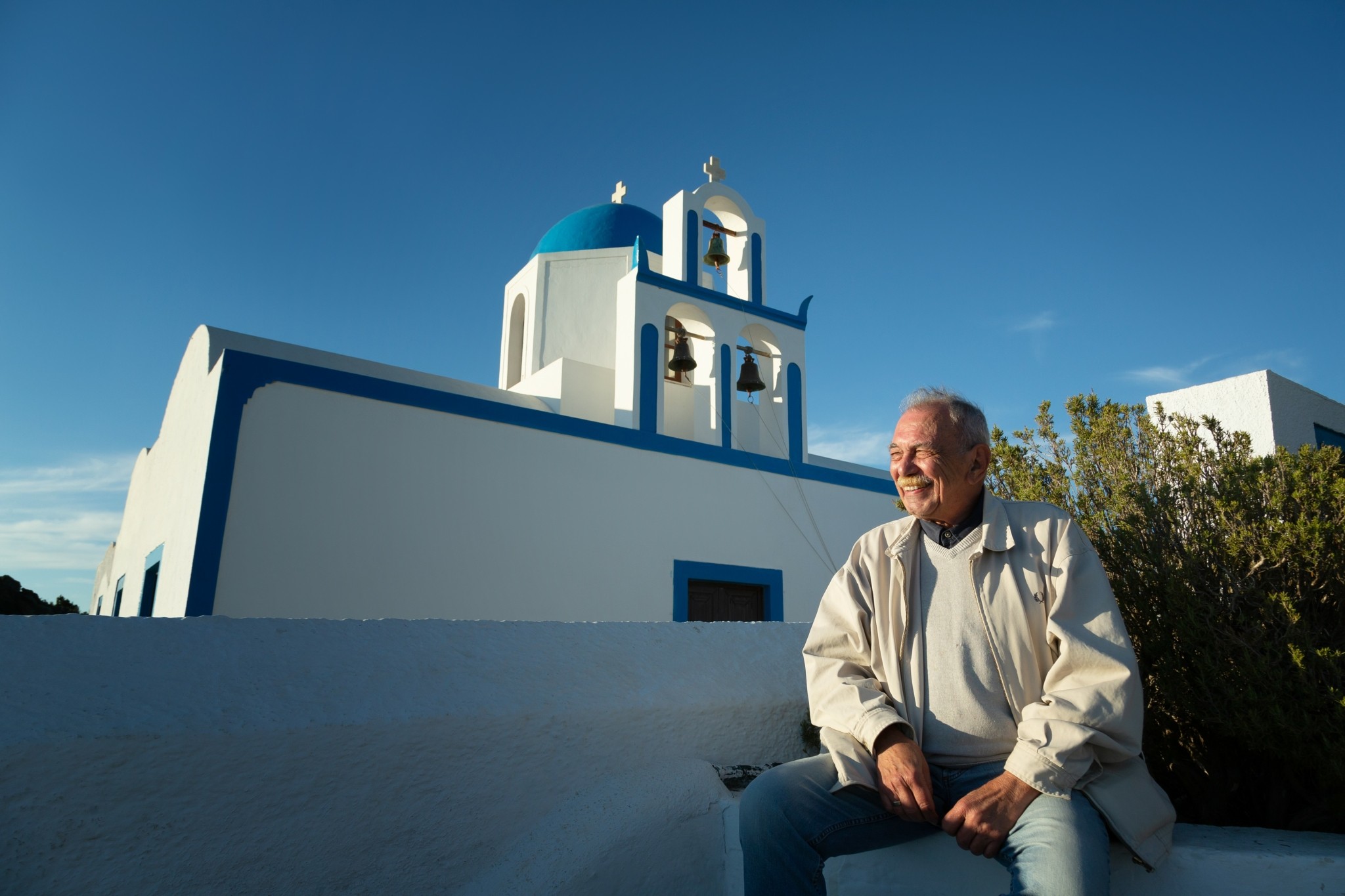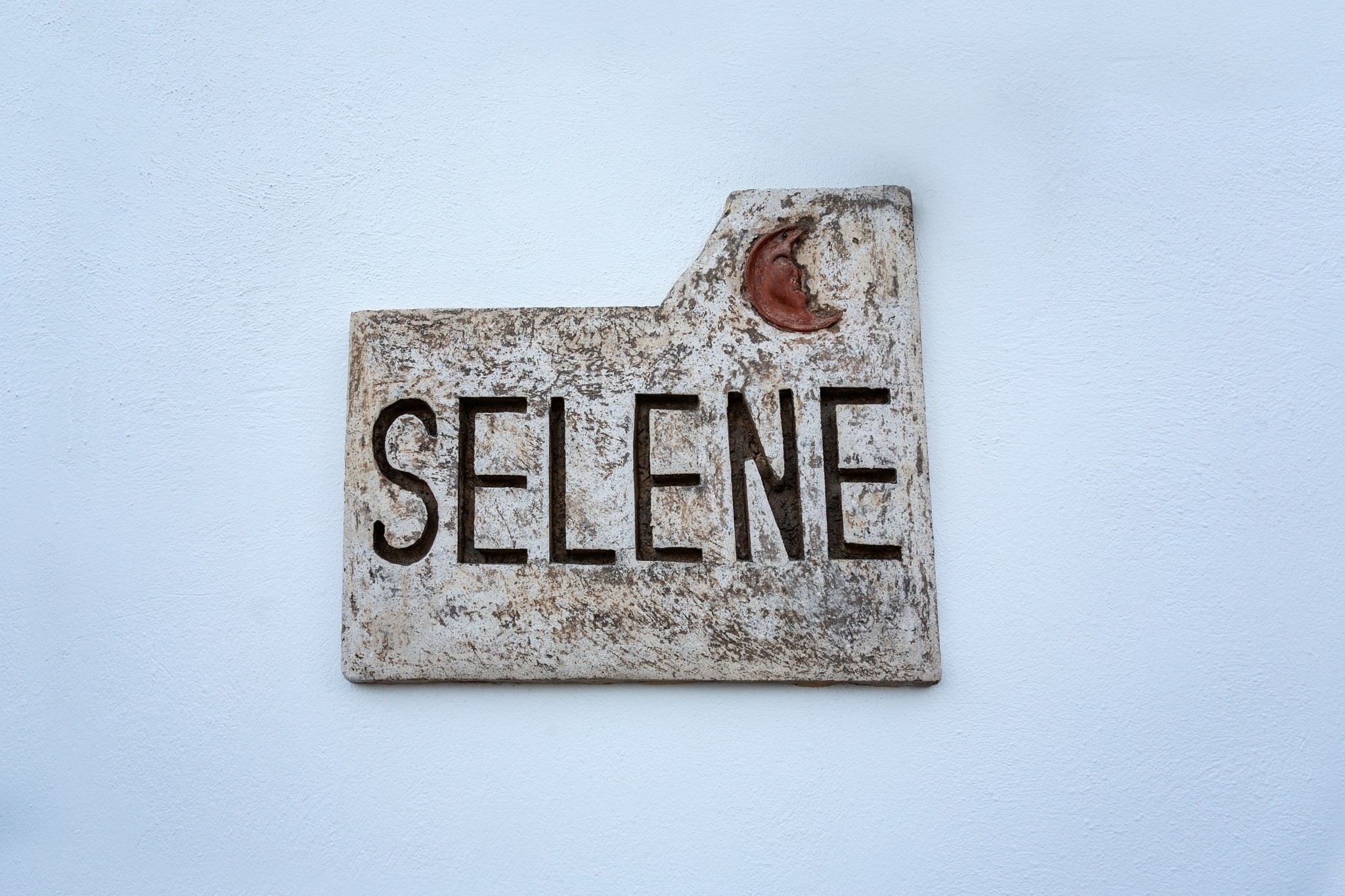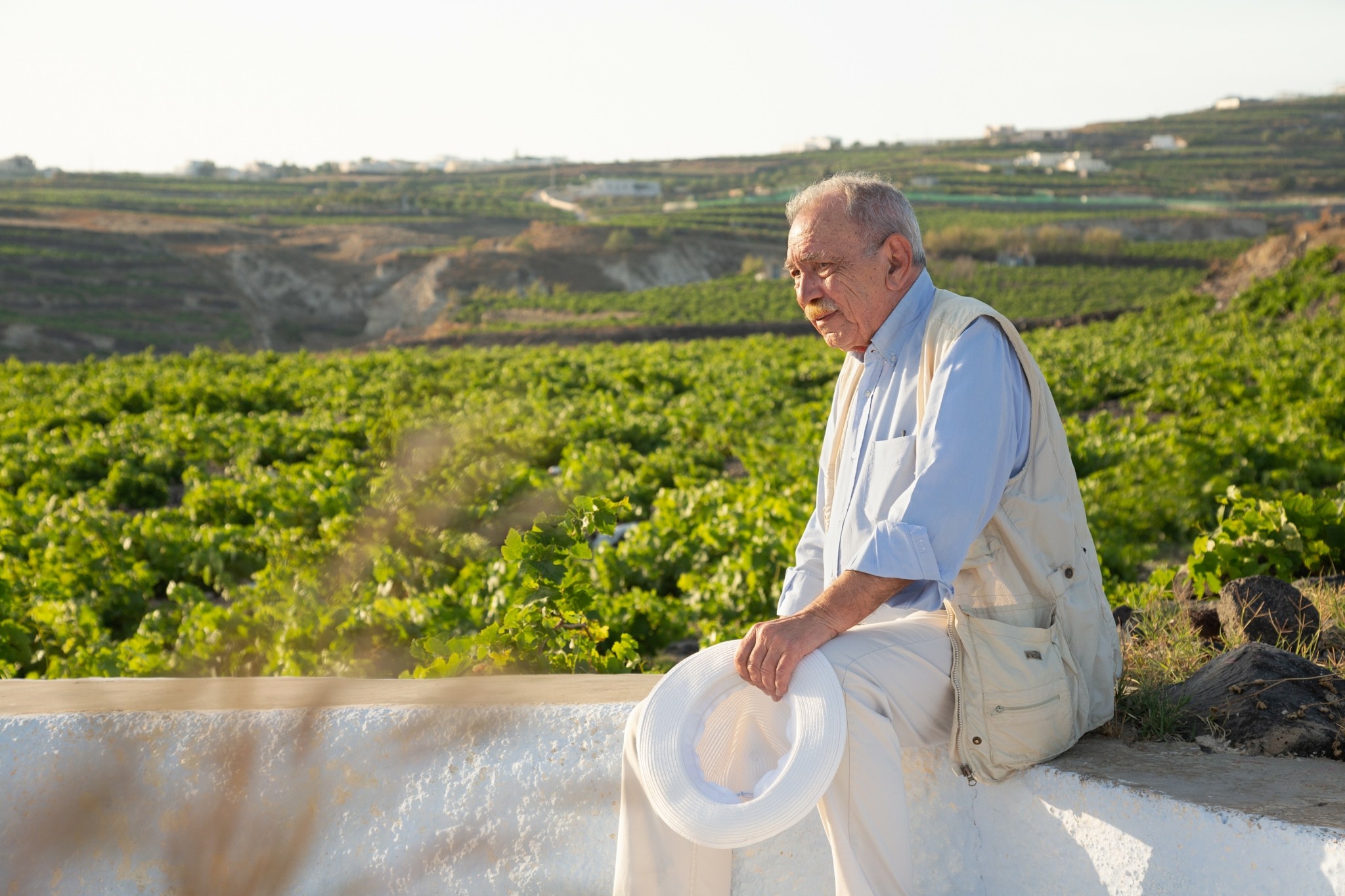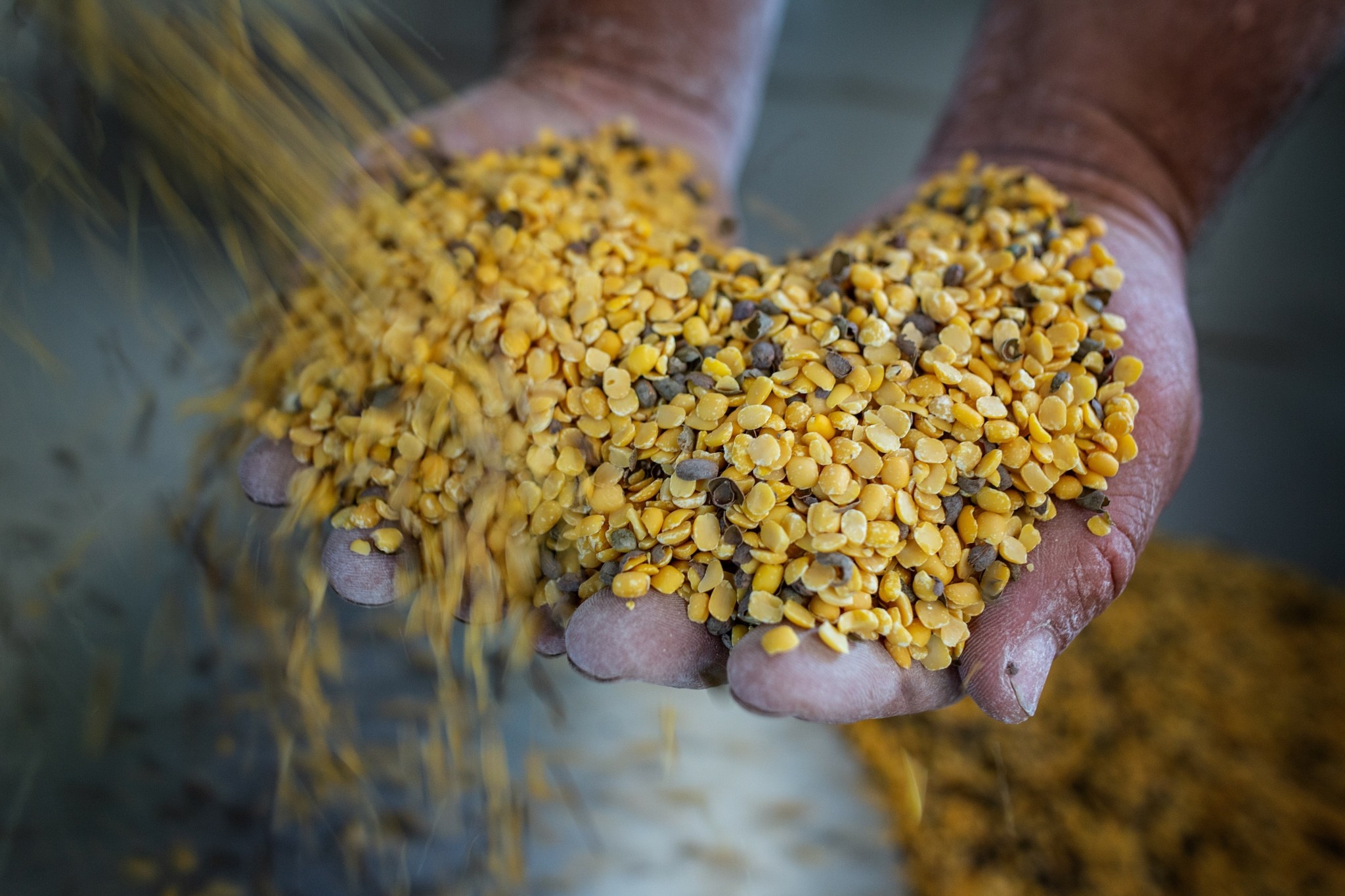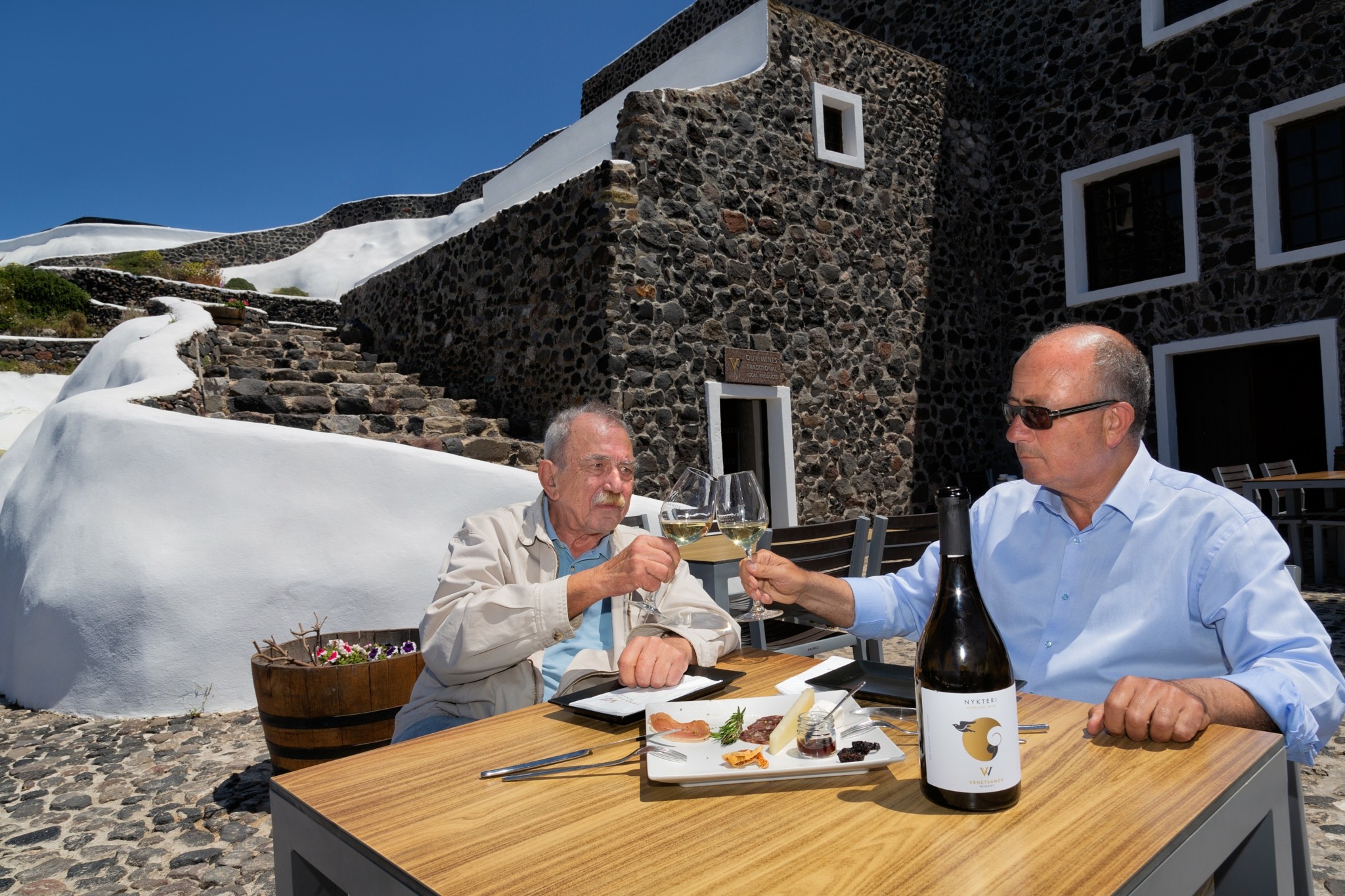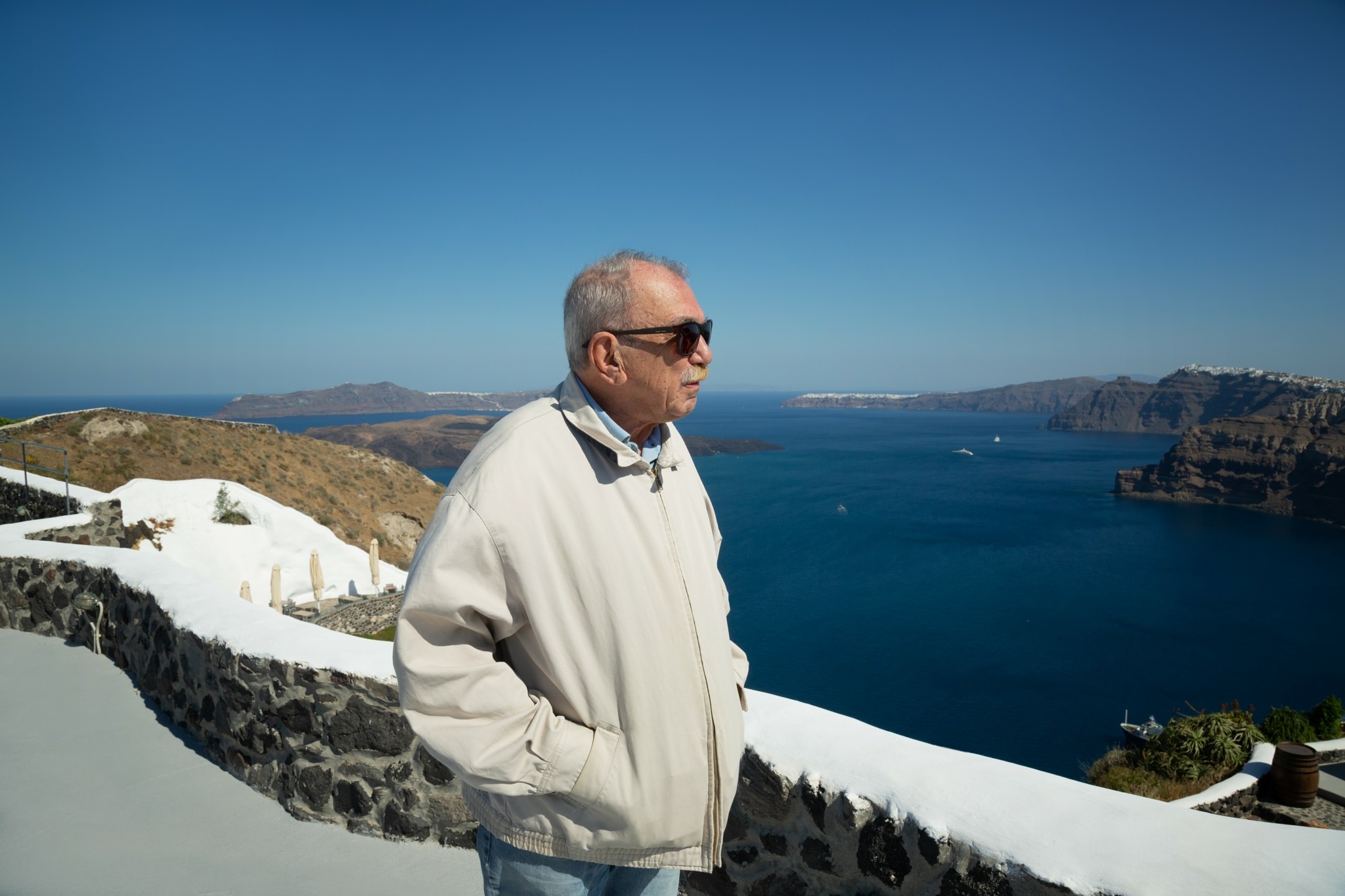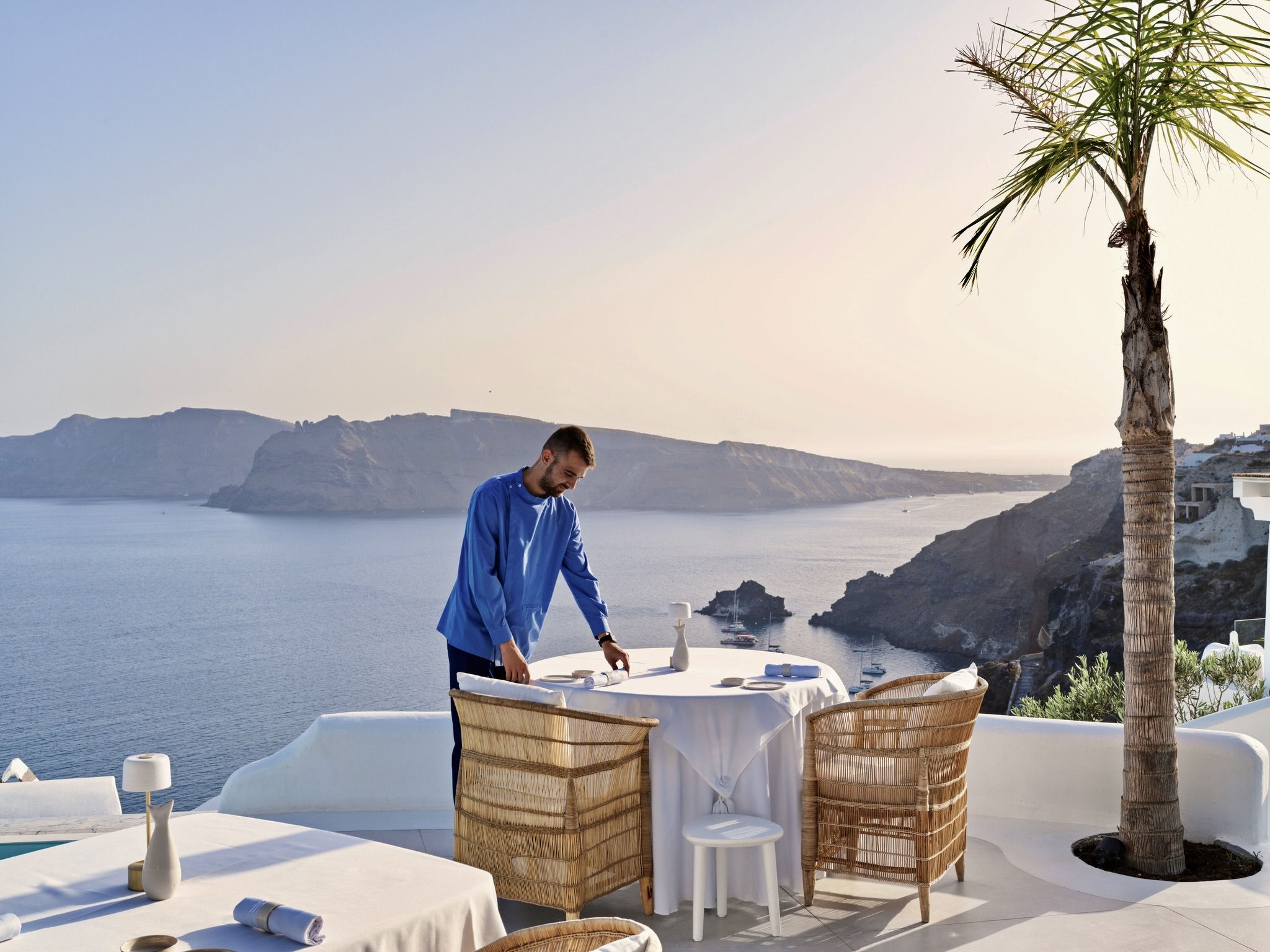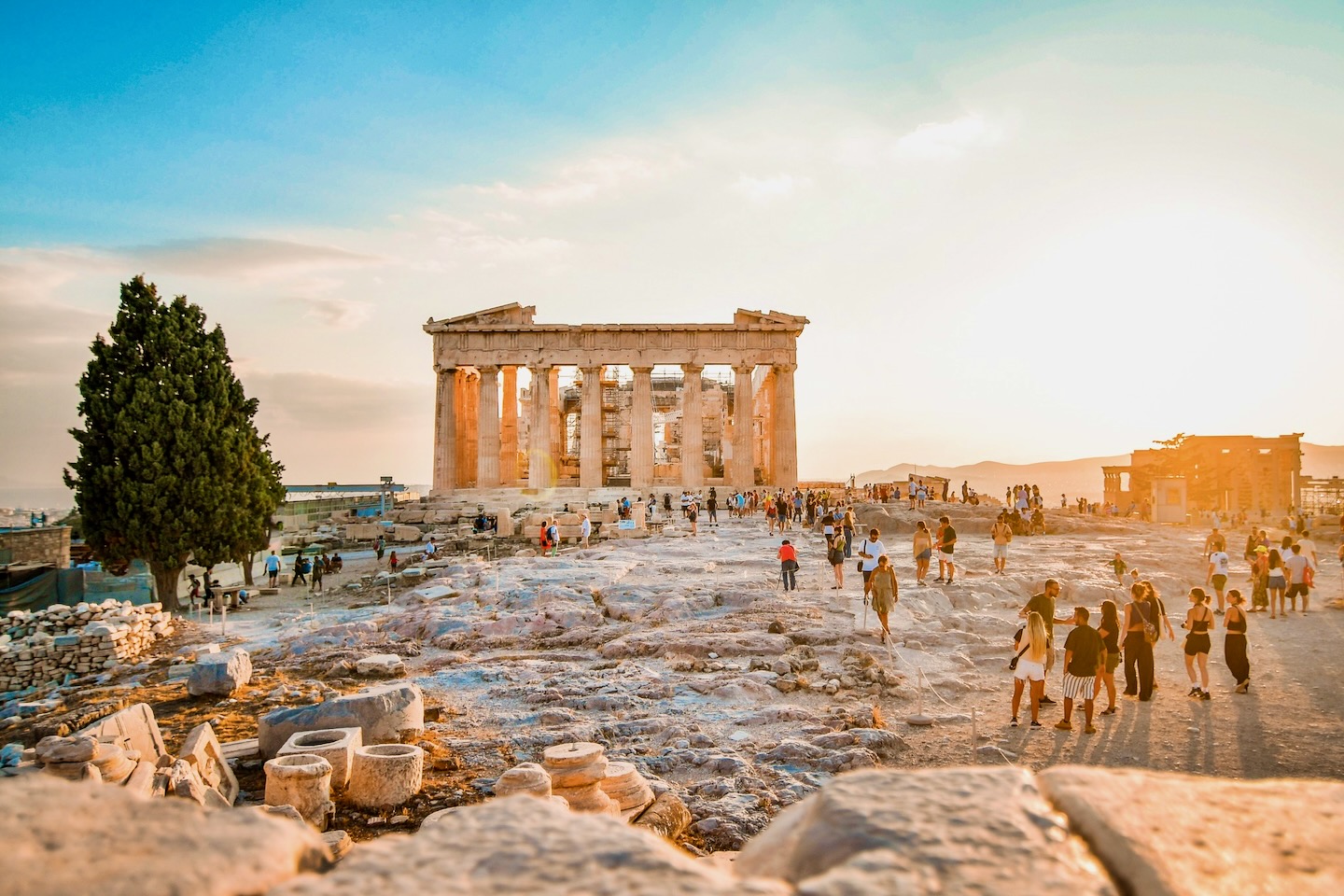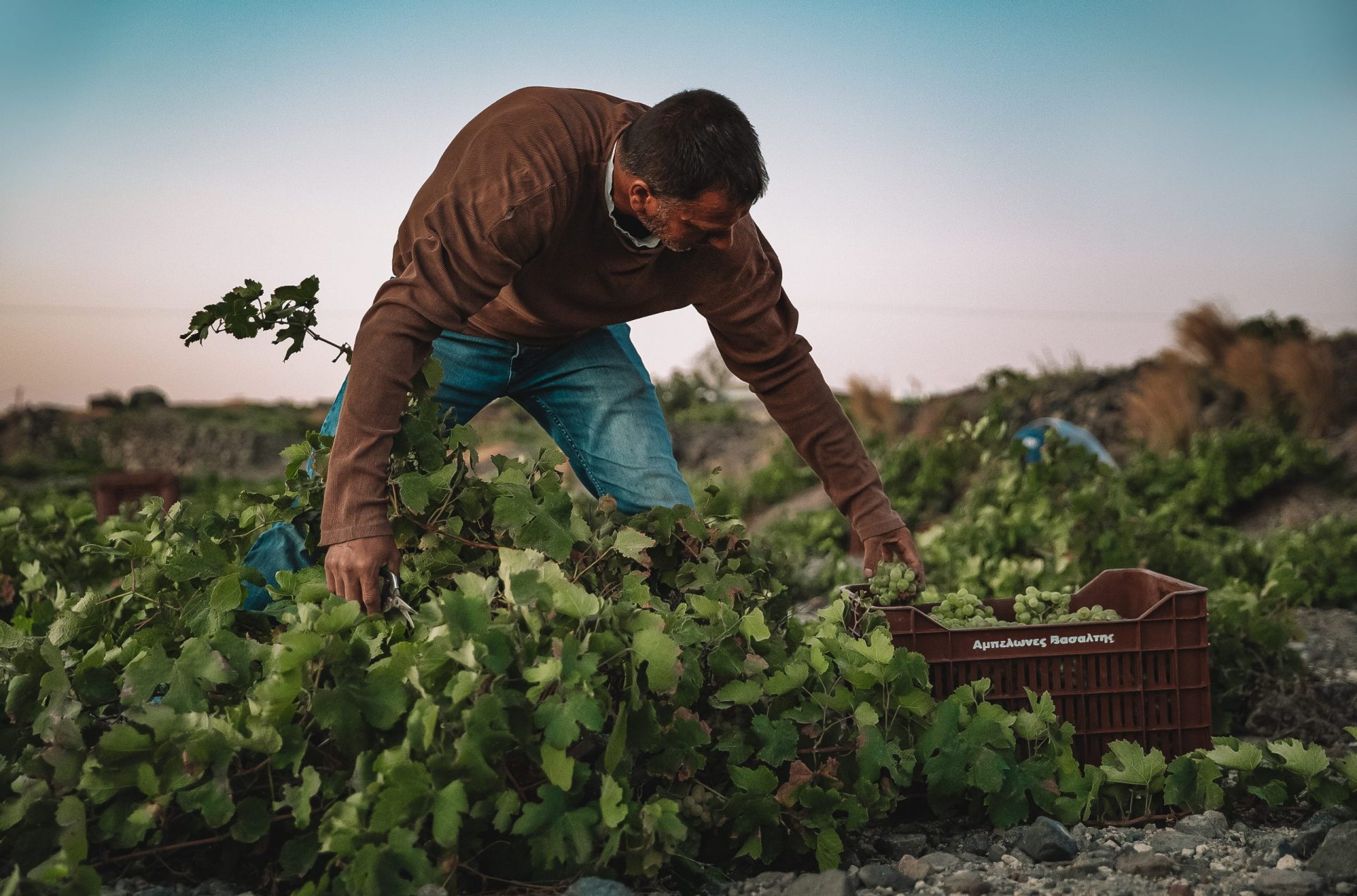George Hatzigiannakis guides us through the fairest island of them all. He takes us on a long walk full of fond memories, interesting discussions and touching encounters with good friends and colleagues.
He hadn’t been on the island since last October. At the end of last season, he said goodbye to his Selene – which had already passed into the hands of a new owner and moved to its new home in Fira – and his colleagues, thus closing this chapter of his life after 35 years. George Hatzigiannakis first came to Santorini in the mid-70s, with his spouse Evelyn and a group of architect friends. Enchanted by its energy, he fell passionately in love with the island. After enjoying it repeatedly as an avid traveller, he soon came to see it as the place where he would spend his summers as a restaurateur.
Until then Hatzigiannakis had nothing to do with this particular job, but he was a lover of travel, good food and wine. A good starting point anyhow. Born in Nikaia, Piraeus in 1946 to parents from Asia Minor, the only experience he had with food was his grandmother’s cooking and the groceries brought home by his grandfather, who before the war ran a café in Kokkinia. Growing up, Hatzigiannakis studied at the Industrial School and worked at various jobs. He opened the Selene in 1986 at the age of 40.
Santorini’s Selene
During its first year, Selene – set in a building in Fira with a large terrace and a captivating view of the volcano, chosen by architect Evelyn- was based on the standards of Athenian restaurants, Hatzigiannakis remembers today. Yet, he quickly realized that this land, where he had chosen to drop anchor, had its own special characteristics, its own unique products and these should be given priority in his restaurant. From the very second summer of Selene’s operation, restaurateur Hatzigiannakis (“a profession that is disappearing fast these days”, as he says) gave priority to Santorini, to this peculiar volcanic and arid island that became his homeland. He focused on fava beans, cherry tomatoes, white eggplants, round zucchini, capers, chlorotyri (a creamy and slightly sour cheese made in Santorini) and wine. And then he turned his gaze to the Aegean Sea, the neighbouring islands and their own unique goodies, such as the delectable cheeses of neighbouring Ios and the many other delicious products he discovered here and there.
And so, his Selene became really famous and his gastronomic turn seems to have influenced more or less his fellow restaurateurs on the island at that time. For, it was not only Hatzigiannakis who had invested first himself and then his savings in this notable land. There were many others who, sooner or later, dropped their own anchors on the island· each from different starting points – from Thessaloniki and Crete and of course from Piraeus, where many Santorinians had moved after the earthquake of 1956 and to whom the emerging tourist development slowly showed the way back.
“It’s not that we did the same things,” Hatzigiannakis says today in relation to the other restaurateurs, some of whom he has been friends with for decades. “But we were all trying to do our best and there was what we call fair play between us, and that was good for everyone, both the professionals and the guests.” He himself, of course, insisting on the locality of raw materials in fine gastronomy, and therefore a pioneer, soon acquired the honorary nickname “patriarch of the Aegean Cuisine”. After all, every Santorinian has his own nickname.
The company with which Hatzigiannakis visited the island for the first time in the 70s was not small and they were all enchanted by the Caldera and the volcano. That first summer on the island, they lived on potatoes and eggs, as well as tomato fritters by the hands of Maroulia, who run the Lauda Hotel in Oia -the summer retreat of Hatzigiannakis’ family. George still remembers that small window in the low-ceilinged room with the incredible view where he –much younger then- would lie down, giving up the larger bed for Evelyn and little Zoe. There are many dear friends and some of them good colleagues- relatives almost- that we meet on our common walks on the island.
The next day
Our first acquaintance is with Georgia Tsara, Hatzigiannakis’ right hand in “Selene” for fifteen consecutive years· excellent hostess, with deep knowledge of the Santorinian cuisine and local wines (she also used to organise cooking classes, wine and food tastings in the restaurant), and our co-guide today on this journey “of the next day” for Hatzigiannakis who left Selene; for Santorini, which is preparing for a more normal tourist season after last summer; and even for us who are returning to the island after almost a decade to conjure up new words and images in a place that is constantly changing. Built and rebuilt, whitewashed, illuminated – I will never forget the bright image of Santorini, as seen from Anafi, its starkly dark sister-island , a couple of years ago. Santorini has turned into a small in size, but huge in volume tourist state, with all that this implies for the island and its population; even when all its visitors are absent, in the heart of winter, the number of residents, Santorinians and non-Santorinians alike, reaches 25,000. The schools are full of children, the streets are full of cars, and the island is full of new roads, carved out from one day to the other· new hotels, new villas, new restaurants, new shops, new umbrella parasols and sun beds.
“It is not an exaggeration to say that the island has lost its rhythm. These are not island rhythms we live in,” says in one of our stops, Yannis Nomikos, owner of the homonymous farm in Vothonas and one of the few Santorinian professional farmers who deal exclusively with local products, their production, standardization and distribution on and off the island. Nomikos had met Hatzigiannakis when the former, at the beginning of his agricultural career, bottled his first wine and took it to the latter to taste it and eventually add it to the menu of Selene. “In the mid-1990s it was an honourable achievement for a wine to be on Selene’s wine list,” he recalls.
Discussions over wine and some fava beans
We tasted wines, both young and old, at the winery of Venetsanos in Megalochori, on the Caldera. “I cannot possibly take you to all twenty wineries on the island, which all produce remarkable wines, but we will definitely go to Venetsano because of its incredible location”, explains Hatzigiannakis. “Here, overlooking the volcano and Akrotiri, is the best place to talk about Santorini” he continues. “For, what is Santorini? It is the eruption of the volcano three and a half thousand years ago that created this stunning landscape; it is the civilization that existed before and was buried under the hot lava, and which today, when discovered in Akrotiri, awes us; and it is the modern civilization that was literally created from the ashes of the previous one. It is Santorini of today, which in some strange way always manages to survive. What is more, this island, which at first glance may seem inhospitable, proves to be particularly fertile, considering the products it produces and the gastronomic possibilities these offer us, and that ultimately inspired my own activity”.
Indeed, in the mid-80s, when Hatzigiannakis first opened his Selene, international cuisine was the absolute trend. This shift to local produce was not without effort. Everyone had to work together – from producers, winemakers and local cooks to restaurant chefs, waiters and Greek customers. Foreigners immediately responded to our cuisine, which was based on local ingredients and flavours, while incorporating new techniques and appearance. That’s how it all started; thus followed the organization of local and international conferences -such as Aegean Cuisine and Slow Food-, the Year of Gastronomy, the journalists, the awards. “We’ve cooked fava beans every which way,” he says with a smile, as he remembers jokingly asking the restaurant’s esteemed chefs to make “fava bean puffs.”
Santorini; the fairest of them all
At the time of the above discussion the wind is blowing keenly. It is midday and the sun is literally over our heads, bright, but luckily not scorching, thanks to the wind. We are at the winery of Venetsanos, which is of great historical importance for the island, as it is the first industrial winery of Santorini. It is located just above the port of Athinios and was founded in 1947. Its main advantage is the multi-storey building, which was constructed in such a way as to significantly reduce energy consumption, mainly by using gravity to transport the must and wine to the port of Athinios for storage in tanks and loading on ships for export. Today it operates as both a museum and a restaurant by the heirs of George Venetsanos, the brothers Nikos and Evangelos Zorzos, who together with the oenologist Ioanna Vamvakouri founded the company Venetsanos Winery.
Here we also make the acquaintance of Nikos Zorzos, former mayor of the island and a good friend of Hatzigiannakis. The conversation revolves around many topics, travels through time, but Santorini always remains at the heart of the discussion. Especially today. “Santorini is like Helen of Troy”, says Zorzos, with a sense of humour. “Always beautiful. The landscape is so imposing that it swallows up any aesthetic aberration.” Then the conversation becomes serious, returning to earlier findings and conclusions. I tell them that I find it very confusing that the different villages and settlements are no longer distinguishable from each other, since there are buildings, even sparsely, almost everywhere. Indeed, the fields have been reduced and the crops have decreased, only the vineyards remain stable or even increase slightly (Santorini wine has an excellent reputation in Greece and abroad), and all the rest looks like an endless construction and not necessarily based on the traditional architecture of the island. In short, the same thing that happens everywhere. And yet, no matter how true all of the above is, no matter how unbearable the traffic and the crowds are, no matter how built-up Oia is (Hatzigiannakis remembers it with a quarter of the buildings when he first came to the island – “and debris everywhere”) – Santorini still remains beautiful. Timelessly beautiful. Like Helen. The view of the Caldera is captivating, breath-taking, swallowing the imperfections. Even today, even so.
What about the Santorinians? The Santorinians certainly got down to business. Moreover, the older ones came back and the younger ones stayed. “Hatzigiannakis got the Santorinians to cook,” I was told in one of the many conversations we had, and the truth is that in Santorini, which is so touristy, there are impressively many restaurants and taverns that serve good food and without necessarily asking for a fortune. Not that there aren’t some that do. In fact, there are. Just like anywhere else.
However, Hatzigiannakis and his friends – old and young – are the only ones who belong to this particular story. The people he introduced us to, the friends he wanted to see on his first five days on the island after a long time: Georgia and Fanis, his dear friends and colleagues at Selene, Christos and Stavros of Skala restaurant in Oia· with whom he has always shared the same love and passion for the island· Manolis, with his messy little balcony in the heart of Oia, the only permanent resident among the many expensive luxury suites· Kostas of Sunflower boutique hotel· Nikos and Giannis, both mentioned above, and Lefteris from Pyrgos, the most picturesque village in Santorini –all of them dedicated to quality tourism, tradition and the island itself. Exactly like George Hatzigiannakis.



